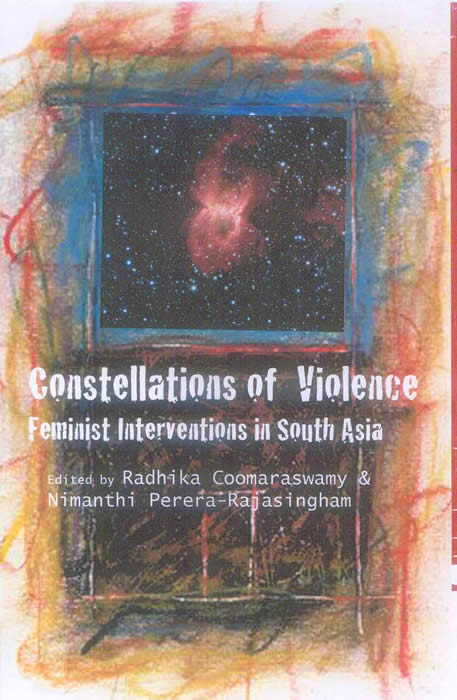Ilankai Tamil Sangam28th Year on the Web Association of Tamils of Sri Lanka in the USA |
|||
 Home Home Archives Archives |
On Violence and Violationby Rumina Sethi, The Hindu, June 1 2008
Constellations of Violence: Feminist Interventions in South Asia, edited by Radhika Coomaraswamy and Nimanthi Perera-Rajasingham, Women Unlimited, 2008, p. 260, Rs. 400. Kumkum Sangari, one of the contributors, pretty much sums up the crux of Constellations of Violence with her claim: “If one were to map the forms of gendered violence in the subcontinent, national borders in South Asia would begin to look somewhat flimsy. India, Pakistan, Bangladesh, Sri Lanka and Nepal Eerie silence One of the constituencies to which the history about women has been most indifferent to is the history of women living in war-torn areas. Kanchana Ruwanpura and Nimanthi Perera-Rajasingham show how in today’s world with its rhetoric of liberalism and human rights, equality and gender mobilisation, it has to be emphasised that sexual violence against women continues unabated in areas of armed conflict. Their essays on military aggression in Sri Lanka interrogate the nature of development aid offered by the U.S. which is mixed up with the bitter pill of the structural adjustment programmes forced upon accepting nations. Another essay by Uma Chakravarti and others on ‘Reclaiming Spaces’ is a virtual manifesto which seeks to replace the trivialising insinuations of ‘eve teasing’ with a more criminal connotation of a ‘violation of the right to bodily integrity’. In a climate of incompetent and feeble systems of government and legal reform, the four authors enumerate the various ways in which the law and justice machinery can be changed to safeguard the position of women at the workplace. But one is yet to see signs of visible change since law in most cases exists on paper only. Theories of traditional Marxism and Radical feminism have been quite ineffectual in fighting violence: Marx was too general in that he included the oppression of women within the overall rubric of exploitation, arguing that once private property is eradicated, the exploitation of women will automatically come to an end. But Engels’s Origin of the Family, Private Property and the State, more specifically addresses the ‘woman question’. Woman-specificRadical Feminism, on the other hand, is more woman-specific in investigating the connection of women with nature and of men with culture. While one side of the ideology represents an ‘androgynous ideal’, the other favours a completely opposite view, that of ‘cultural feminism’ which affirms the affinities between women and nature or men and culture. Suffice it to say, academics have moved so far away from grassroots reality that unless a bridge between the two is built, activism will remain a distant dream. ----------------------------------------------------------
| ||
 share several, though not all, forms of violence which reveal substantial overlaps and similarities.” The Ahmedabad Action Group report says that an estimated 1,000 women are burned in the State of Gujarat alone every year. Outside the subcontinent, in the United States, for instance, wife battering is the prime cause of injury to women. Astonishingly, over 4,000 women yearly get beaten to death. One in 10 Canadian women get battered by their partner. Every nine minutes a woman gets raped in Mexico. Every 10 days one woman is beaten to death in Sweden.
share several, though not all, forms of violence which reveal substantial overlaps and similarities.” The Ahmedabad Action Group report says that an estimated 1,000 women are burned in the State of Gujarat alone every year. Outside the subcontinent, in the United States, for instance, wife battering is the prime cause of injury to women. Astonishingly, over 4,000 women yearly get beaten to death. One in 10 Canadian women get battered by their partner. Every nine minutes a woman gets raped in Mexico. Every 10 days one woman is beaten to death in Sweden.